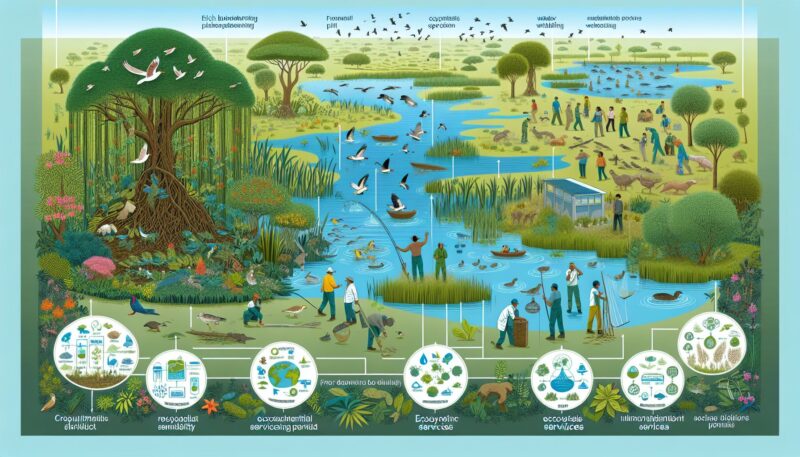Wetlands are among the most productive and biologically diverse ecosystems on Earth, providing a myriad of services that benefit both the environment and human populations. Spanning from marshes and bogs to swamps and estuaries, these natural wonders play a crucial role in maintaining ecological balance and supporting biodiversity. In this comprehensive exploration of wetlands, we will delve into their ecological importance, the threats they face, and the urgent need for their conservation.
What Are Wetlands and Why Are They Important?
Wetlands are areas where water covers the soil or is present at or near the surface for varying periods during the year, including the growing season. Because of this, wetlands support a wide range of plant and animal life that is adapted to these moist conditions. They provide critical habitat for many species, act as natural water filters, and serve as buffers against floods and coastal storm surges.
Types of Wetlands
– Marshes
These are characterized by soft-stemmed vegetation and are typically found at the edges of lakes and streams. They are frequently flooded, and they have a high biological productivity.
– Swamps
Swamps feature mostly woody plants and trees. They can be found in both freshwater and saltwater environments and are integral to the ecology of their surrounding areas.
– Bogs
Acidic and spongy, bogs have a buildup of peat, or partially decomposed vegetation, and often have a carpet of sphagnum moss. They accrue peat deposits and store carbon, thus playing a part in regulating the global climate.
– Estuaries
These are coastal wetlands where rivers meet the sea, mixing fresh water with saltwater. Estuaries are among the most productive ecosystems in the world, providing essential services such as nursery grounds for fish and other aquatic species.
– Fens
Similar to bogs, fens are less acidic and have higher nutrient levels. They are fed by groundwater and support a diverse array of plant and animal life.
Ecosystem Services Provided by Wetlands
Wetlands contribute significantly to environmental sustainability through a variety of ecosystem services. These include:
– Water Filtration
Wetlands act as natural filters for water passing through them. Plants and soils in wetlands absorb and break down pollutants, which helps to purify water and reduce the burden on our water treatment facilities.
– Flood Control
By absorbing excess rainfall and releasing it slowly over time, wetlands reduce the risk of floods. They serve as natural sponges, soaking up stormwater and easing the flow into rivers and streams.
– Shoreline Stabilization and Storm Protection
Wetlands along coastlines absorb the energy of waves and storm surges, protecting the land behind them. The presence of plant roots helps to consolidate sediment and reduce erosion.
– Carbon Sequestration
Wetlands capture carbon from the atmosphere and store it within plants and soils, which is crucial for mitigating the impacts of climate change.
– Biodiversity Support
Many species of birds, fish, and invertebrates depend on wetlands for food, shelter, breeding grounds, and migration stops. Wetlands are often hotspots of biodiversity.
– Recreation and Tourism
Wetlands provide opportunities for fishing, birdwatching, photography, and other recreational activities that contribute to the economy.
Threats to Wetlands
Despite their value, wetlands have been subjected to significant threats, including:
– Drainage for Agriculture
Wetlands have historically been drained to create arable land, leading to habitat destruction and the loss of the numerous ecological services they provide.
– Urban Development
Expansion of urban areas often comes at the expense of wetlands, which are filled in to make way for housing and infrastructure.
– Pollution
Agricultural runoff, industrial waste, and urban effluents introduce pollutants into wetlands, threatening water quality and the health of aquatic life.
– Climate Change
Rising sea levels, altered precipitation patterns, and an increase in the occurrence of extreme weather events pose an existential threat to many wetland systems.
– Invasive Species
Non-native plants and animals can outcompete indigenous species, leading to reduced biodiversity and alterations to the wetland ecosystem function.
Wetland Conservation and Restoration
The conservation of wetlands is critical for maintaining their ecological functions and the services they provide. Conservation efforts include:
– Legal Protections
Legislation such as the Ramsar Convention, an international treaty for the conservation and sustainable use of wetlands, protects wetlands and their resources.
– Restoration Projects
Efforts to restore degraded wetlands can re-establish some of the lost ecosystem services. This often involves re-introducing native vegetation and removing invasive species.
– Sustainable Management
Methods such as buffer zones, sustainable agriculture practices, and responsible urban planning can mitigate the impact of human activity on wetlands.
– Public Education and Involvement
Educating communities about the value of wetlands and involving them in monitoring and protection efforts can lead to more effective conservation.
– Research and Monitoring
Scientific research and regular monitoring are necessary to deepen our understanding of wetlands and to inform and adapt management practices.
Conclusion
Wetlands are indispensable to the health of our planet, providing crucial services to humanity and nature alike. However, they are disappearing at an alarming rate and need urgent protection. Continued conservation and restoration of wetlands, supported by sound policies and active community involvement, are essential for the sustainability of not only these ecosystems but also for the well-being of future generations.
References
Note: This is a crafted example article provided for an educational purpose. The information is accurate as of the knowledge cutoff date, and any changes in data or scientific consensus that have occurred after that date will not be reflected in the content.
